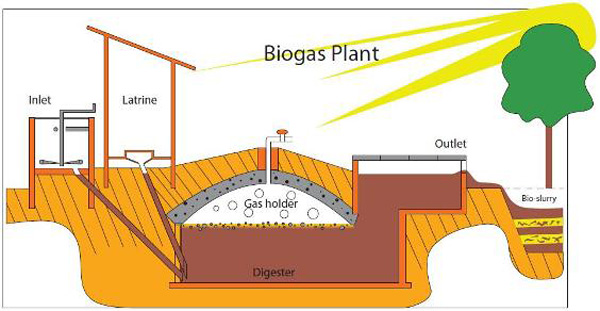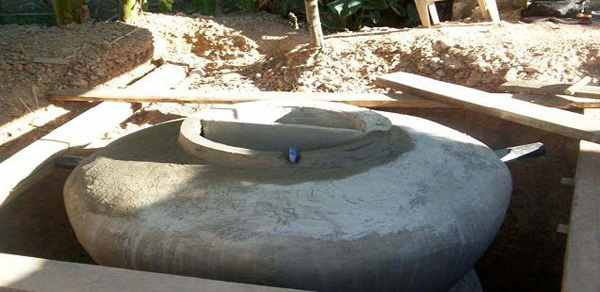
Our blog focuses on low cost, sustainable ways of building homes with local resources. It’s equally exciting and practical learning about alternatives to costly centralized grid systems (electrical, gas, sewer, water) that tend to lock people into the system and make them vulnerable to price controls. Biogas is one of many renewable energy systems that provide greater independence at very low cost. Biogas is especially practical in rural areas where running power and gas lines are cost prohibitive. Distributed systems such as biogas and other biofuels, solar water heaters, wood stoves, solar ovens, etc. located at or near the source typically keep functioning during times of emergencies. When a whole city or region is without power, water and sewer during a blizzard, your family can be safe and snug.

“Biogas typically refers to a gas produced by the biological breakdown of organic matter in the absence of oxygen. Organic waste such as dead plant and animal material, animal feces, and kitchen waste can be converted into a gaseous fuel called biogas. Biogas originates from biogenic material and is a type of biofuel.
Biogas is produced by the anaerobic digestion or fermentation of biodegradable materials such as biomass, manure, sewage, municipal waste, green waste, plant material, and crops. Biogas comprises primarily methane (CH4) and carbon dioxide (CO2) and may have small amounts of hydrogen sulphide (H2S), moisture and siloxanes.
The gases methane, hydrogen, and carbon monoxide (CO) can be combusted or oxidized with oxygen. This energy release allows biogas to be used as a fuel. Biogas can be used as a fuel in any country for any heating purpose, such as cooking. It can also be used in anaerobic digesters where it is typically used in a gas engine to convert the energy in the gas into electricity and heat. Biogas can be compressed, much like natural gas, and used to power motor vehicles. In the UK, for example, biogas is estimated to have the potential to replace around 17% of vehicle fuel. Biogas is a renewable fuel, so it qualifies for renewable energy subsidies in some parts of the world. Biogas can also be cleaned and upgraded to natural gas standards when it becomes biomethane.
In India, Pakistan and Bangladesh biogas produced from the anaerobic digestion of manure in small-scale digestion facilities is called gobar gas; it is estimated that such facilities exist in over two million households in India and in thousands in Pakistan…
The Chinese have been experimenting with the applications of biogas since 1958. Around 1970, China had installed 6,000,000 digesters in an effort to make agriculture more efficient. During the last years the technology has met high growth rates.”
Source: Wiki
Image source:
How to Build a Low-cost Ferrocement Biogas Digester (lots of alternatives shown)
Earthbag Biogas Plant
Resilient Communities: Don’t Throw Away Your Wealth
Low-fired Brick Biogas Plant
Ashden case studies

If anyone considers making electricity with the biogas, in a silent and maintenance free solution with a 1-2kW linear free Piston Stirling Engine, please visit http://www.microgen-engine.com
Gerwin Lubbers
Hi,
very interesting information! When it come to the slurry pruced by a system connected to latrines how to make sure that the pathogens load (colforms and E.coli mainly) are reduced during the digestion? IS is safe to dispose the slurry in the environment with no further treatment?
can you suggest any additional post digester treatment for the slurry?
thanks for your help!
ciao
Millions of these biogas plants have been built in places like Asia. I’m sure you can find books with all the technical details. I just googled the search words biogas plant book and found numerous links.
One good choice would be Biogas Technology: http://www.ait.ac.th/news-and-events/2010/ait-in-the-news/may/book-title-biogas-technology/
I would like to build a mini biogas plant in greel (OUTSIDE OF MY FLAT) Please guide me
You’ll have to search for the details and experiment. YouTube has lots of good videos.
Thanks for this informative article, with equally useful comments and replies. Thoroughly enjoyed all of it.
The US government has recently published a report called Biogas Opportunities Roadmap (link below) that I think many here would find useful:
http://energy.gov/sites/prod/files/2014/08/f18/Biogas%20Opportunities%20Roadmap%208-1-14_0.pdf
i want to build a biogas for my farm but i have some questions to ask
1. can i use a metal drum for the biogas digester?
2. how long will the digester stay before i evacuate it?
3. can the gas be stored in gas cylinder( i intend to store the gas and take it home because the farm is far from my house)
4. do i need to be pouring the slurry everytime i clean the farm into the digester.
your answer will help us in descision making
thank you
You’ll have to buy a book for the details. Maybe you can find the answers online.
Our family installed biogas (8 cubic meter) in 1992. This plant has been producing cooking gas enough for a family of six during these last 22 years. In 2009, the plant was thoroughly cleaned and the dome repainted from the inside to make it air-tight. We will not be surprised if this plant lasts another 20+ years. Initially we had one buffalo, and then over time the number of cattle varied between 1-3. We have also connected human toilet directly into the plant from the very beginning. I think if there is any Gaia machine on earth, this plant is the one–completely recycles ‘wastes’, produces fuel for cooking. The amount of fuel varies depending on the length of the day and surface temperature, with reduced fuel during a few winter months in Nepal’s plains (elevation less than 400 msl). http://www.bspnepal.org.np/?option=cms&cid=16 This is the publicly available design for a typical Nepali smallholder household (farming 1/2 ha of land). Chinese have been experimenting with different materials such as fiber-glass pre-fab models, but the ones in Nepal are constructed with some cement, concrete, bricks and a few metal pipes for transporting gas.
Thank you very much for your comment. It’s always good to hear firsthand accounts from those with experience.
What is main constituent of biogas. Is it highly inflammable.I mean dangerous to be used in household or small scale industry.If yes what precautions are to be taken.
How many hours work is needed monthly to maintain it.
http://www.edoubts.com/questions/the-chief-constituent-of-gobar-gas-is-/?edr397#.U5kwe3KSzQA
Thank you.Regards
Wiki says: “It is primarily methane (CH4) and carbon dioxide (CO2)” http://en.wikipedia.org/wiki/Biogas
Millions of biogas plants have been built — over 2 million in India alone.
While I don’t have firsthand experience, these plants are probably simple and efficient or they wouldn’t be so popular.
Danger: use the same precautions as any other cooking gas.
Mass production of standardized units seems like the next trend: https://naturalbuildingblog.siterubix.com/biotech-india-biogas-plants/
(Biotech still hasn’t responded to my inquiry and so I suspect they are having problems keeping up with demand.)
hi please may I get a quotation for how to make a small scale biogas plant it is for a small orphanage in my country that needs help thank you
We don’t do that. We’re only reporting on interesting stories.
Pakistan Science Club (PSC) is also promoting biogas plant installation in the country. PSC has published many articles and uploaded video tutorials pertaining to biogas plant construction – See more at: http://www.paksc.org/
pls deatails pls
Is it possible to build a biogas plant out of cob, adobe, or some other natural material instead of ferrocement? How?????
You could use earthbags and cement plaster. This would be more labor intensive than ferrocement. Also consider low-fired brick (excellent choice if you can find them).
http://www.motherearthnews.com/diy/low-fired-brick.aspx
Did you ever find a biogas reactor that was small and free of construction that can be used by the poorest of the poor.
They’re not free, but yes there are low cost versions being used by many people in China, India, etc.
Biogas is an amazing technology. We built our own in 1992 June. After 18 years, we got it dredged, and it is back to full operation and we hope the dome lasts for at least another twenty years. We use cattle poop and have our toilet connected to the digester (as shown in the picture)–so no separate structure, the slurry is excellent fertilizer. We have pigeon nests built directly above the slurry outlet tank and therefore the slurry gets ample doses of phosphorous. You forgot mention Owen, Nepal has the highest per capita use of biogas digester in the world. It is already in half a million households and is expected to reach 1 million in a decade–even with all the lousy governments in place. As over 80 percent of Nepali households are still agricultural smallholder with at least one cattle, it can be easily scaled up to 5 million households.
Thanks for the update. Excellent comments. I particularly like how you’re using pigeons as part of the process and how Nepal plans to continue to expand their biogas program. All things considered, biogas seems like one of the most practical and efficient alternative energy systems.
Much better!!!! Loads the way it should.
I love your information and will be checking back often! Peace on earth!
I’ve been curious about gassification for a while, I’m glad you posted this! I once saw a video of a green engineering student who made latrine gassifiers for people in third world countries. The family would be able to cook on occasion with the collected methane.
I was thinking about trying to create a combination composting toilet and gassifier (although i’m not sure how that would effect the smell). I wonder how much a gassifier like the one shown would cost?
Wood gassifiers are also a great form of energy and can be outfitted to pickup trucks.
It wouldn’t likely be worthwhile to make a biogas plant for just one latrine unless you’re extremely poor and have no other options.
You could probably build one for a few hundred dollars, depending on local costs. You could rig up something for less if you use plastic barrels and salvaged parts. There are lots of plans to choose from on the Internet.
I think it would be easier and more practical to use biogas in a vehicle (from your biogas plant) than rig up a wood gasifier. Wood gasifiers are bulky and quite a nuisance in comparison to using biogas stored in a spare tank. Note Jean Pain’s biogas truck in the post a few days ago — that’s extremely efficient!
To provide sufficient fuel for a household, a biogas plant typically needs 1-2 cows and/or additional livestock or wastes from multiple houses.